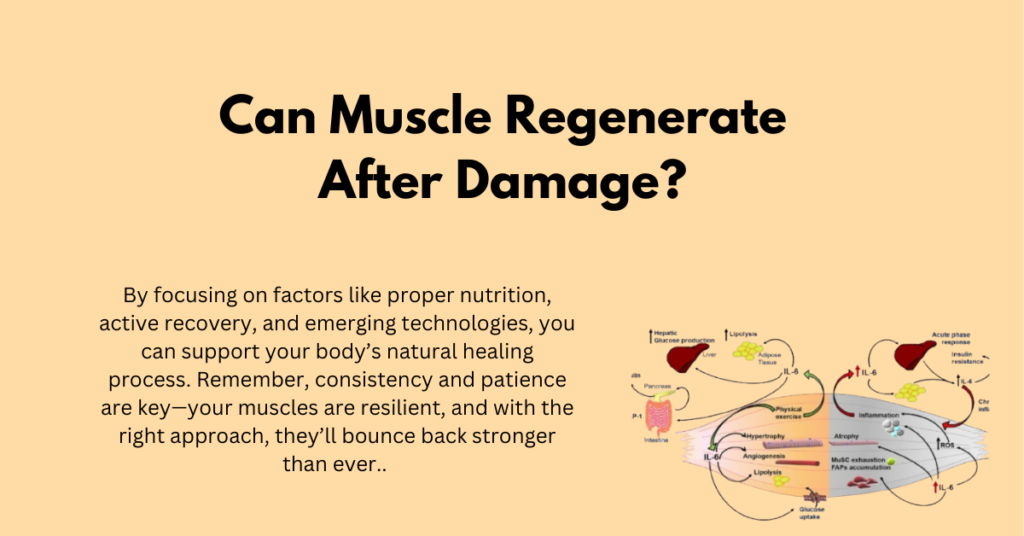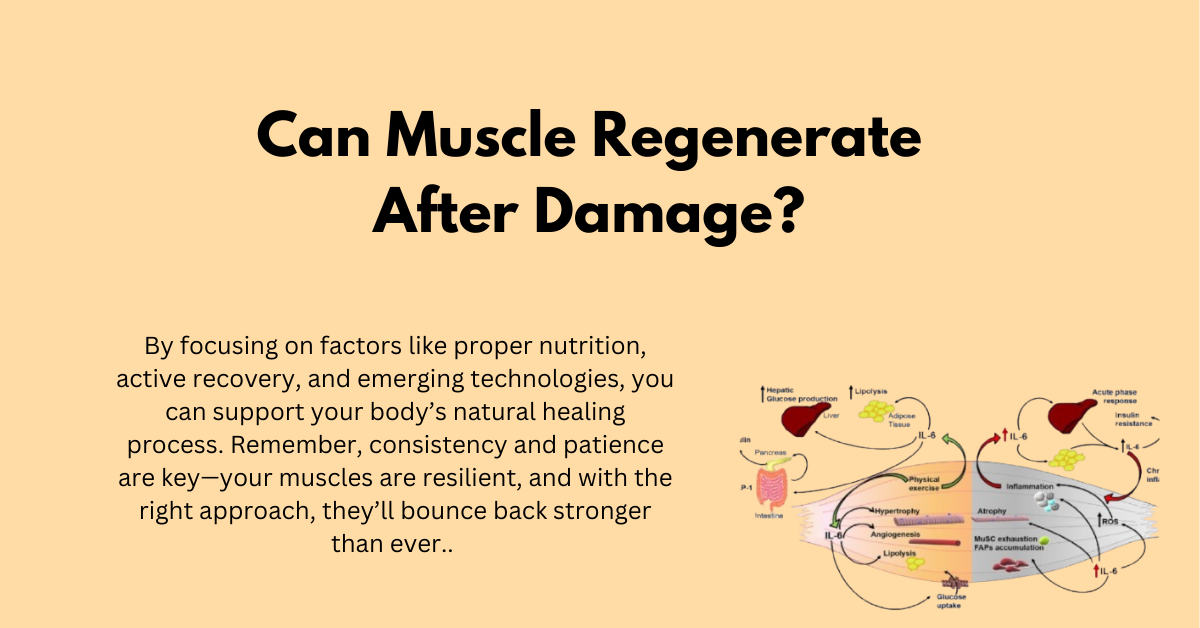Can Muscle Regenerate After Damage? Understanding the Body’s Remarkable Healing Process. In this article, we’ll explore whether muscle can regenerate after damage, the science behind the process, and practical strategies to optimize recovery. Understanding this remarkable ability enables you to make informed decisions about your health and fitness journey.

1. The Science of Muscle Damage and Repair
Muscle fibers can sustain damage in several ways, including physical trauma, overuse, or diseases like muscular dystrophy. When these fibers tear or sustain injury, the body activates a complex repair mechanism. But can muscle regenerate after damage completely? The answer depends on the severity and type of damage.
In general, skeletal muscle tissue has a significant ability to regenerate, thanks to specialized cells called satellite cells. These cells act as a repair system, helping to rebuild damaged fibers and restore muscle function. When activated by signals from the injured site, satellite cells proliferate and fuse to form new muscle tissue, facilitating recovery.
2. Factors Affecting Muscle Regeneration After Damage
While the body is capable of muscle regeneration, the process is influenced by several factors. These include:
- Age: Muscle regeneration tends to slow down as you age due to reduced satellite cell activity.
- Nutrition: Proper nutrition is crucial for providing the building blocks needed for muscle repair.
- Severity of damage: Minor strains heal faster than severe tears or injuries.
- Lifestyle: Sleep, hydration, and exercise habits significantly impact recovery speed.
Understanding these factors helps answer the question, “Can muscle regenerate after damage?” by revealing the conditions necessary for optimal healing.
3. The Role of Nutrition in Muscle Regeneration
Nutrition plays a pivotal role in the body’s ability to regenerate muscle after damage. To support recovery, prioritize these essential nutrients:
- Protein: Amino acids, the building blocks of protein, are critical for muscle repair. Lean meats, eggs, dairy, and plant-based options like lentils and tofu are excellent sources.
- Carbohydrates: Replenishing glycogen stores ensures your muscles have the energy needed for recovery.
- Vitamins and minerals: Vitamin C, zinc, and magnesium contribute to tissue repair and inflammation reduction.
For individuals asking, “Can muscle regenerate after damage faster with supplements?” the answer is often yes. Protein powders, BCAAs, and creatine are effective tools to support healing.
4. How Exercise Impacts Muscle Recovery
Exercise is both a cause of muscle damage and a solution for regeneration. Activities such as weightlifting and high-intensity workouts create microtears in muscle fibers, which the body repairs to build stronger, more resilient muscles. However, overtraining can hinder regeneration.
To ensure muscle can regenerate after damage effectively, incorporate these recovery-focused practices:
- Active recovery: Low-impact activities like walking or swimming improve circulation and promote healing.
- Rest days: Give your body time to repair and rebuild by scheduling rest days into your routine.
- Proper warm-ups and cool-downs: Prepare your muscles for exercise to reduce the risk of severe damage.
5. Can Muscle Regenerate After Severe Damage?
In cases of severe muscle injuries, such as those caused by accidents or surgery, the body’s natural repair mechanisms face greater challenges. While satellite cells are highly effective, extensive damage may result in scar tissue formation, which lacks the functionality of healthy muscle fibers.
For these situations, rehabilitation exercises, physical therapy, and, in some cases, medical interventions like stem cell therapy can enhance the ability of muscle to regenerate after damage. Advances in regenerative medicine are offering new hope for individuals with severe injuries.
6. The Importance of Rest and Sleep
Sleep is an often-overlooked component of muscle recovery. During deep sleep, the body releases growth hormone, a critical factor for tissue repair and regeneration. To maximize the body’s ability to regenerate muscle after damage, prioritize 7-9 hours of quality sleep per night.
- Establish a sleep routine: Go to bed and wake up at the same time daily.
- Create a relaxing environment: Dim lights and avoid screens before bedtime.
- Consider naps: Short naps can boost recovery, especially after intense workouts.
7. Managing Inflammation for Faster Regeneration
Inflammation is a natural response to muscle damage, but prolonged or excessive inflammation can delay recovery. Managing this response is crucial for ensuring muscle can regenerate after damage efficiently. Strategies include:
- Cold therapy: Ice packs reduce swelling and pain in the initial stages of recovery.
- Anti-inflammatory foods: Incorporate foods like turmeric, ginger, and fatty fish into your diet.
- Massage therapy: Regular massages improve circulation and reduce tension.
8. Emerging Technologies in Muscle Regeneration
For those wondering, “Can muscle regenerate after damage using advanced technologies?” the answer lies in ongoing innovations in the medical field. Cutting-edge treatments include:
- Stem cell therapy: Researchers are exploring how stem cells can repair damaged tissue more effectively.
- Electrical stimulation: Devices that stimulate muscle contractions may enhance recovery.
- 3D bioprinting: While still experimental, this technology aims to create replacement muscle tissue for severe injuries.
9. Psychological Factors and Muscle Recovery
Mental health and stress levels also influence the body’s ability to regenerate muscle after damage. Chronic stress can elevate cortisol levels, which inhibits tissue repair. To support recovery, incorporate stress-reduction techniques like:
- Meditation and mindfulness practices.
- Deep breathing exercises.
- Engaging in hobbies or activities that bring joy.
10. Real-Life Examples of Muscle Regeneration Success
Stories of athletes and individuals recovering from significant muscle injuries highlight the body’s resilience. For example, professional athletes often undergo rigorous rehabilitation to return to peak performance after injuries. These cases demonstrate that muscle can regenerate after damage with the right strategies and mindset.
Conclusion
So, can muscle regenerate after damage? Absolutely. The human body is designed to repair itself, and with proper care, nutrition, and rest, it’s possible to restore muscle function and strength. Whether you’re recovering from a workout or a more serious injury, understanding the science of muscle regeneration and implementing effective recovery techniques will help you achieve your goals.
By focusing on factors like proper nutrition, active recovery, and emerging technologies, you can support your body’s natural healing process. Remember, consistency and patience are key—your muscles are resilient, and with the right approach, they’ll bounce back stronger than ever.

